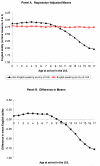What Holds Back the Second Generation? The Intergenerational Transmission of Language Human Capital Among Immigrants
- PMID: 18584062
- PMCID: PMC2440707
What Holds Back the Second Generation? The Intergenerational Transmission of Language Human Capital Among Immigrants
Abstract
In 2000 Census microdata, various outcomes of second-generation immigrants are related to their parents' age at arrival to the United States, and in particular whether that age fell within the "critical period" of language acquisition. We interpret this as an effect of the parent's English-language skills and construct an instrumental variable for parental English proficiency. Estimates of the effect of parent's English-speaking proficiency using two-stage least squares yield significant, positive results for children's English-speaking proficiency and preschool attendance, and significant, negative results for dropping out of high school and being below age-appropriate grade. (JEL J13, J24, J62).
Figures




References
-
- Angrist Joshua D., Lavy Victor. The Effect of a Change in Language of Instruction on the Returns to Schooling in Morocco. Journal of Labor Economics. 1997;15(1):S48–S76.
-
- Black Sandra E., Devereux Paul J., Salvanes Kjell G. Why the Apple Doesn't Fall Far: Understanding Intergenerational Transmission of Human Capital. American Economic Review. 2005;95(1):437–449.
-
- Bleakley Hoyt, Chin Aimee. Language Skills and Earnings: Evidence from Childhood Immigrants. Review of Economics and Statistics. 2004a;86(2):481–496.
-
- Bleakley Hoyt, Chin Aimee. University of Houston Mimeo; Feb, 2007. English Proficiency and Social Assimilation among Childhood Immigrants: An Instrumental-Variables Approach.
Grants and funding
LinkOut - more resources
Full Text Sources
